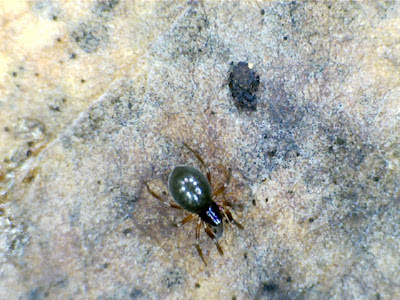Wednesday, 27 February 2013
A leggy centipede
I was pleased to come across this centipede Stigmatogaster subterranea in leaf litter while gardening. I counted 79 leg segments - with a pair of legs each -, a normal number for this species, which can easily be the leggiest beast in the garden. Winter has been very long this year: no bees or butterflies, or even droneflies, and very few active invertebrates around, so BugBlog remains dormant, but hopefully not for long.
Sunday, 17 February 2013
Morning-glory plume moth
While gardening this afternoon in the lovely spring weather I disturbed this plume moth, Emmelina monodactyla. She fluttered slowly and settled on the wall adopting its usual T-shape position with folded wings protecting their feathery divisions. The first moth of the year for me.
More information
UKmoths page for Emmelina monodactyla
More information
UKmoths page for Emmelina monodactyla
Labels:
Emmelina monodactyla,
moths,
plume moth
A little collection of litter springtails
I have been gathering leaves from the garden and bringing them inside to look for springtails. I was enticed to give them some more attention after spending some time checking the awesome photographs of Eddy Nurcombe in Flickr. They transport you to a strange and tantalising world where everything is relative. Apparently gigantic millimetre long beasts with dark stern eyes tower over other bugs as big as a speck of dust. I wanted to have a glimpse by myself so, armed with the hand held digital microscope I set up to explore the leaf litter. Springtails are a group of hexapods - as are insects - but, unlike insects, they are primarily flightless. They still have six legs and a pair of antennae, like insects, but lack long cerci on their rear ends, like diplurans. Most springtails have a forked spring folded under their abdome, the furcula, which they can released when disturbed, and gives them their name. Despite this, some springtails are springless, and many soil living ones have lost all pigment and eyes. Surface dwelling springtails may be covered on iridescent scales, or be hairy and can be surprisingly colourful.
Springtails are important part of soil ecosystems and feed on decomposing plants and animals, excrement, fungi, algae, and bacteria, others are predators of smaller animals. They are predated by many organisms, including small birds, spiders, harvestmen, centipedes
There are over 250 sp of British springtails, and at first, that seems a bit discouraging as to trying to identify them. In addition, they can be minuscule! The largest UK springtails are around 6 mm, and the smallest are 0.2 mm, close to the limit of what is visible with the naked eye (especially if you are starting to be a little long sighted!). On the positive side, some of the common species are quite distinctive and with a little practice, identifying others to genus can be done, with a little help of macrophotography.
More information
A photographic key to common UK springtails.
Collembola of Britain and Ireland. Steve Hopkin's site with distribution maps.
Checklist of the Collembola. With lots of info on springtail biology.
Springtails are important part of soil ecosystems and feed on decomposing plants and animals, excrement, fungi, algae, and bacteria, others are predators of smaller animals. They are predated by many organisms, including small birds, spiders, harvestmen, centipedes
There are over 250 sp of British springtails, and at first, that seems a bit discouraging as to trying to identify them. In addition, they can be minuscule! The largest UK springtails are around 6 mm, and the smallest are 0.2 mm, close to the limit of what is visible with the naked eye (especially if you are starting to be a little long sighted!). On the positive side, some of the common species are quite distinctive and with a little practice, identifying others to genus can be done, with a little help of macrophotography.
Lepidocyrtus cyaneus, an iridescent blue springtail
Tomocerus minor, another iridescent springtail.
I was trying to take some photos of one of these lovely Hypogastrura purpurescens. They look rubbery and matt, in contrast to the iridescent species...
...when this tiny spider jumped onto the field of vision and ate one of them - just visible at the front of the spider. I wished I had taken a video of that!
Despite its name, this is one of the large springtail species, Tomocerus minor, here posing with a woodlouse
A relative of the Lion Springtail, the handsome Orchesella cincta
I like to call this species the Lion springtail, as it's got a wonderful mane (also top photo). Orchesella villosa. I often find in on fallen apples (top).
Cyphoderus albinus, a springtail often found in ant nests.
Protaphorura sp. a large aggregation on a rotting plant. This is actually a springless springtail, as it does not have a furca. Also, as the previous one, it has no eyes or pigment, as they often live underground.
Entomobrya intermedia
Now I see springtails everywhere. Click to see the full resolution photo and you will notice that there are many springtails - and some bark lice - around these overwintering Harlequins.
More information
A photographic key to common UK springtails.
Collembola of Britain and Ireland. Steve Hopkin's site with distribution maps.
Checklist of the Collembola. With lots of info on springtail biology.
Labels:
leaf litter,
Springtails
Subscribe to:
Posts (Atom)















